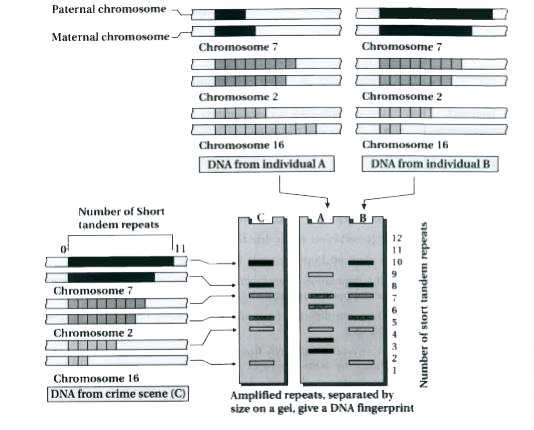Describe the technique of DNA fingerprinting.
Text Solution
Technique of DNA Fingerprinting : Alec Jeffreys initially developed DNA fingerprinting also known as DNA typing or DNA profiling to find out markers for the inherited diseases.
He used a satellite DNA as probe that shows very high degree of polymorphism and called it variable number of Tandem Repeats (VNTRs).
The technique involved southern blot hybridisation using radiolabelled VNTR as a probe. The technique has the following steps:
(i) DNA isolations : DNA is extracted from the cells in a high speed centrifuge.
(ii) Amplification : Amplification many copies of the extracted DNA can be made by the use of polymerase chain reaction.
(ii) Digestion : Digestion of DNA by restriction endonucleases.
(iv) Separation : Separation of DNA fragments by electrophoresis.
(v) Southern Blotting : Transfer of separated DNA fragments to synthetic membranes (like nylon or nitrocellulose).
(vi) Hybridisation : With the help of radiolabelled VNTR probe (small segments of DNA which help to detect the presence of gene in a long DNA sequence) which gets attached to single stranded VNTRs having complementatry nucleotide sequences.
(vii) Autoradiographic Exposure to X-Ray films : Detection of hybridised DNA fragments by autoradiography.

Schematic representation of DNA fingerprinting : Few representative chromosomes have been shown to contain different copy number of VNTR. For the sake of understanding different colour schemes have been used to trace the origin of each band in the gel. The two alleles (paternal and maternal) of a chromosome also contain different copy numbers of VNTR. It is clear that the banding pattern of DNA from crime scene matches with individual B, and not with A.
This shows many dark bands of different sizes.
A small DNA sequence is arranged tandemly in many copy numbers, which varies from chromosome to chromosome in an individual.
The number of repeats show very high degree of polymorphism.
As the size of VNTR varies from 0.1 - 20 kb.
Consequently, after the hybridisation with VNTR probe, the autoradiogram gives many bands of different sizes.
Thus these bands will give characteristic pattern for an individual DNA.
The VNTRs of two persons may be of same length and sequence at certain sites, but vary at other sites.
Therefore it differs from person to person in a population except in the case of monozygotic (identical) twins.
The VNTR belong to a class of satellite DNA known as minisatellite and are essential for DNA of fingerprinting.
The sensitivity of this technique has been increased by using PCR (Polymerase Chain Reaction).
Applications of DNA fingerprinting : (a) Used as a tool in forensic investigations. (b) To settle paternity disputes.(c) To study evolution by determining the genetic diversities among population.
|
Topper's Solved these Questions
- MOLECULAR BASIC OF INHERITANCEBOOK - KUMAR PRAKASHANCHAPTER - MOLECULAR BASIC OF INHERITANCEEXERCISE - SECTION - B (DIFFERENCE/SCIENTIFIC REASON)
12 Videos
- MOLECULAR BASIC OF INHERITANCEBOOK - KUMAR PRAKASHANCHAPTER - MOLECULAR BASIC OF INHERITANCEEXERCISE - SECTION - C (OBJECTIVE QUESTIONS - ANSWERS)
54 Videos
- MODEL QUESTION PAPER FOR ANNUAL EXAMBOOK - KUMAR PRAKASHANCHAPTER - MODEL QUESTION PAPER FOR ANNUAL EXAMEXERCISE - Part- B ( Section C)
4 Videos
- ORGANISMS AND POPULATIONSBOOK - KUMAR PRAKASHANCHAPTER - ORGANISMS AND POPULATIONSEXERCISE - SECTION - F (MULTIPLE CHOICE QUESTIONS)(MCQs ASKED IN COMPETITIVE EXAM)
103 Videos
Similar Questions
Knowledge Check
Which of the following is not required for any of the techniques of DNA fingerprinting available at present
ADNA -DNA hybridizationBPolymerase chian reactionCZinc finger analysisDRestriction enzymesWhich of the following is not required for any of the techniques of DNA fingerprinting available at present
APolymerase chain reactionBZinc finger analysisCRestriction enzymesDDNA-DNA hybridizationWhich of the following is not required for any of the techniques of DNA fingerprinting available at present
APolymerase chain reactionBZinc finger analysisCRestriction enzymesDDNA-DNA hybridization
In the technique of DNA fingerprinting, digestion of DNA is followed by
View SolutionBriefly describe the technique employed in DNA fingerprinting
View SolutionWhich of the following is not required for any of the techniques of DNA fingerprinting available at present ?
View SolutionWhich of the following is not required for any of the techniques of DNA fingerprinting available at present
View SolutionIn the technique of DNA fingerprinting, digestion of DNA is followed by
View Solution
